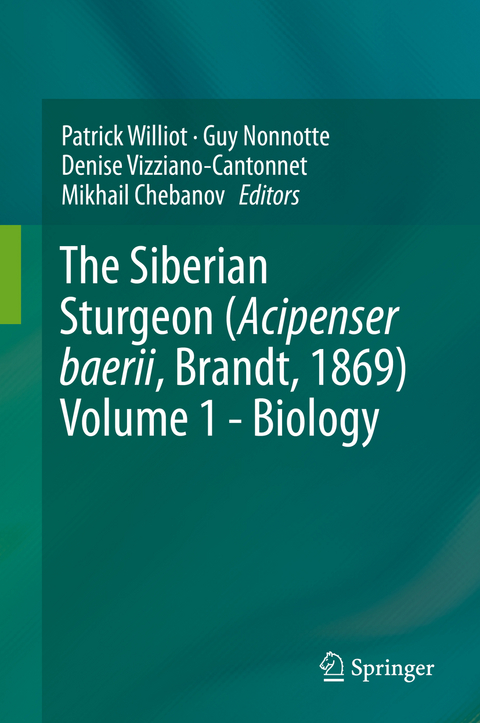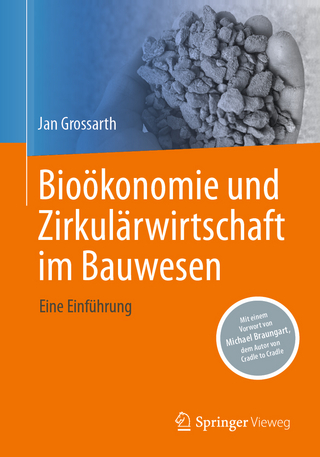
The Siberian Sturgeon (Acipenser baerii, Brandt, 1869) Volume 1 - Biology
Springer International Publishing (Verlag)
978-3-319-61662-9 (ISBN)
The biology of the Siberian sturgeon, Acipenser baerii Brandt 1869, has become a very attractive subject of investigation for biologists since the 1980s. This volume 1 is part of a two-volume set devoted to the species, the second of which focuses on farming. The present volume is divided into three parts: Biology and ecology, Biology and physiology of reproduction, and Ecophysiology, i.e. adaptation to the environment.
The first part addresses a broad range of topics, such as: the ecology, including a new approach to species-specificity, a new insight on the mineralization of vertebral elements, two approaches to sex determination, transposable elements in the gonads, early ontogeny, olfaction and gustation, nutrition and swimming. The second part includes neurochemical and anatomical descriptions of the central nervous system and an updated version of the oogenesis, the characteristics of both sperm and spermatozoa, and a synthesis on gonadal steroids (synthesis, plasmatic levels and biological activities). In turn, the third part reveals how the physiology of the species changes depending on environmental factors such as oxygen, ammonia, and nitrite. Some fundamental consequences of ammonia are developed (sublethal and lethal levels, effects on gill epithelium and haematology, acid-base balance, on AA and adenyl nucleotides levels in plasma, brain and muscle tissue). In addition, the book includes two methodological chapters dealing with fish dorsal aortic cannulation and respiration physiology.
Patrick Williot Patrick spent the three quarters of its professional career primarily to take the challenge of the disappearing of the European sturgeon, Acipenser sturio. To achieve this task, he mobilized all the means of research (both applied and fundamental lines, biological model, national and international cooperation’s), and management (private-public partnership, transfer of know-how, installation of a new experimental facility, search for regular financial support). Patrick has developed his activity around the couple [aquaculture-conservation biology]. Patrick stimulated the development of sturgeon farming primarily in France based on the biological model, the Siberian sturgeon, Acipenser baerii. He has been the kingpin of the First International Symposium on sturgeon held in Bordeaux in 1989 where he launched the concept of the international association for the conservation of sturgeons which was installed (the WSCS; wscs.info) some year later. Later on, he edited the peer-reviewed proceedings (Acipenser), served as scientific committee member of further International symposia on sturgeons as well as the sturgeon specialist group of the IUCN, and organized other symposia and workshops. He succeeded in obtaining for the first time the controlled reproduction of farmed European sturgeon in 2007 which avoided the species from a complete disappearing and opened the door for a restoration. Patrick initiated and carried out the edition of a book on Biology and Conservation of the European sturgeon (2011) and on the biology and farming of the Siberian sturgeon which is in process. Patrick published about 90 papers in peer-reviewed journals or books. Professor Guy NonotteDoctor of the University of Strasbourg, Guy NONNOTTE was appointed research officer at the CNRS in the Laboratory of Comparative Physiology of the Regulations at F-Strasbourg in 1974. He conducted original research especially on cutaneous respiration and skin ionic exchanges on many models of freshwater and sea-water fish. In 1986, he joined the Laboratory of Neurobiology and Compared Physiolgy, (CNRS and University of Bordeaux I, F-Arcachon) and pursued research on extracellular acid-base balance and cell volume regulation in fish exposed to environmental changes and pollutants with a specific interest for the model « Siberian sturgeon ». He supervised a thesis on the toxicity of ammonia for the Siberian sturgeon in collaboration with Dr. Patrick Williot. He took also the opportunity to initiate an important collaboration concerning the respiration, the acid-base balance and the physiological effects of environmental stress for the Siberian sturgeon with the Laboratory of Animal Physiology, F-Brest. In 1994, he was appointed Professor of Animal Physiology (fish physiology) at the University of Brest (France) and managed the Laboratory of Cellular Biology and Physiology. He wrote numerous publications in international reviews and managed several thesis on fish physiology. He was also appointed for numerous evaluations and jury of thesis by INRA, IFREMER, INSERM and CNRS. In 2002, he was designed Vice-President of the University of Brest, responsible of the research and in 2007, Emeritus-Professor of the Brest University. Dr. Denise Vizziano CantonnetDenise Vizziano Cantonnet is a Professor of the Facultad de Ciencias at the Universidad de la República Oriental del Uruguay (UdelaR) and at the Post-Graduate program Programa de Desarrollo de Ciencias Básicas (PEDECIBA). She is Researcher of the Government System of National Researcher (ANII) and Head of the Department of Animal Biology (UdelaR). She is Doctor of the University of Rennes I (U-Rennes I, France) and made a post-doctoral stay at the INRA of Rennes (France). She worked as Invited Professor at U-Rennes I. She conducted original research on reproductive endrocrinology of fish working in different species of commercial importance as trouts, silverside, croakers and developed for 20 years a Training Course on Reproductibe Phsyiology of Fish for Latino American students promoting the development of this new area of research in the Latin America. She was invited as Professor at different Universities of Latin America (Argentina, Brazil, Chile, Colombia, Peru) interested to develop Endocrinology of Reproduction of native species key for fish farming. She started to work in Siberian sturgeons when the producers contacted the University to reproduce the species in Uruguay. The first reproduction in captivity of the south hemisphere has been done in Uruguay together with Dr. Patrick Williot by applying the methodology developed by this Researcher in the CEMAGREF (France). She started the first worldwide investigations in the molecular basis of sex differentiation in sturgeons and built a complete gonadal transcriptome of Siberian sturgeons in order to search the master gene for sex determination and genes involved in sex differentiation. In cooperation with specialists on fish evolution (Dr. Jean Nicolas Volff and Dr. Frederic Brunet, University of Lyon) a first study on retrotrasposons has been made using the gonadal transcriptome. A multi-tissue transcriptome is recently built for Siberian sturgeons in cooperation with Ing. Christophe Klopp (Inra, Toulouse) and the team of Dr. Vizziano are now searching for a genetic sex marker that will improve the fundamental research and will have an impact in sturgeon production. Mikhail S. Chebanov, Prof.,Dr.Sc. is Professor of Department of Aquatic Bioresources and Aquaculture of Kuban State University and Director of State Regional Centre for Sturgeon Gene Pool Conservation “Kubanbioresursi”, Ministry of Natural Resources (Krasnodar , Russia). He has developed technology of the all-year-round reproduction of the different sturgeon species as well as the selection and breeding program and the formation of largest sturgeon living gene bank. He was developed and widely implemented the method of ultrasonic diagnostics of sturgeon for optimization of broodstock management. In 2004 he was awarded by Prize of Government of Russia in the field of Science and Technology for “Development and Implementation of technology of control reproduction and commercial rearing of sturgeon “Many years Chebanov serve as director of South Branch Federal Center of Genetics and Selection for Aquaculture, consultant FAO and convener – ad hoc Working Party on Management of Sturgeons European Inland Fisheries Advisory Commission (EIFAC FAO), deputy chair and member – Sturgeon Specialists Group of the World Conservation Union (IUCN). Prof. Chebanov is co-founder and member of Board of Directors – World Sturgeon Conservation Society (www.wscs.info ) and has chaired numerous workshops and conference sessions, including several International Symposia on Sturgeon (1993-2017). He is the author of more than 170 scientific papers, including 12 books.
General Introduction to the Siberian Sturgeon Books with a Focus On Volume 1 Dedicated to the Biology of the Species.- Part I: Biology & Ecology.- Wild Populations: Geographical Distribution, Ecological and Biological Characteristics of the Siberian Sturgeon Species.- Species Specificity: What Makes the Difference Between the Siberian Sturgeon and the Ponto-Caspian Sturgeon Species?.- Anatomy: Anatomic Description.- Skeleton: The Axial Skeleton of the Siberian Sturgeon Development Organization, Structure and New Insights on Mineralization and Ossification of Vertebral Elements.- Sex: Evolution of Molecular Investigations on Sturgeon Sex Determination and Most Recent Developments in DNA Methylation with a Focus on the Siberian Sturgeon.- Sex Determination and Differentiation of the Siberian Sturgeon.- Genetics: Analysis of Transposable Elements Expressed in the Gonads of the Siberian Sturgeon.- Ontogeny: Early Ontogeny in the Siberian Sturgeon.- Behavior: Behavior of Early Life Stages in the Siberian Sturgeon.- Sensory Capacity: Olfaction and Gustation in Acipenseridae, with Special Reference to the Siberian Sturgeon.- Nutrition: Nutritional Requirements of the Siberian Sturgeon: An Updated Synthesis.- Swimming: Swimming Characteristics of the Siberian Sturgeon.- Part II. Biology & Physiology of Reproduction.- Central Nervous System: Chemical Neuroanatomy of the Hypothalamo-Hypophyseal System in Sturgeons.- Oogenesis: An Updated Version of Histological and Ultrastructural Studies of Oogenesis in the Siberian Sturgeon Acipenser Baerii. Male Function: Sperm and Spermatozoa Characteristics in the Siberian Sturgeon.- Reproductive Physiology: Gonadal Steroids: Synthesis, Plasmatic Levels and Biological Activities in Sturgeons.- Steroid Profiles Throughout the Hormonal Stimulation in Females Siberian Sturgeon Acipenser Baerii Brandt.- Part III. Ecophysiology: Adaptation to Environment.- Respiratory Responses to Hypoxia in the Sturgeon, Acipenser Baerii.- Effects of Exposure to Ammonia in Water: Determination of the Sublethal and Lethal Levels in Siberian Sturgeon.- Consequences of High Levels Ammonia Exposure on the Gills Epithelium and on the Haematological Characteristics of the Blood of the Sturgeon, Acipenser Baerii.- Acid-Base Balance and Ammonia Loading in the Sturgeon Acipenser Baerii, Exposed to High Concentrations of Ammonia.- Effects of Exposure to Ammonia on Plasma, Brain and Muscle Concentrations of Amino-Acids and Adenyl Nucleotides in the Sturgeon, Acipenser Baerii.- The Importance of Water Quality in Siberian Sturgeon Farming: Nitrite Toxicity.- Part IV. Specific Methods.- Cannulation in the Cultured Siberian Sturgeon, Acipenser Baerii Brandt.- Some Basic Methods in Respiratory Physiology Studies Applied in the Siberian Sturgeon.- General Conclusionsof the Volume 1: Recent Progress in the Biology of Acipenser Baerii, An Exciting Subject for Further Academic Research and Development of Aquaculture.
| Erscheinungsdatum | 12.09.2017 |
|---|---|
| Zusatzinfo | XVII, 497 p. 159 illus., 54 illus. in color. |
| Verlagsort | Cham |
| Sprache | englisch |
| Maße | 155 x 235 mm |
| Gewicht | 840 g |
| Themenwelt | Naturwissenschaften ► Biologie ► Ökologie / Naturschutz |
| Naturwissenschaften ► Biologie ► Zoologie | |
| Weitere Fachgebiete ► Land- / Forstwirtschaft / Fischerei | |
| Schlagworte | Acipenser baerii • agricultural science • Agriculture • Animal physiology • Biomedical and Life Sciences • Caviar • conservation • Conservation of wildlife & habitats • Conservation of wildlife & habitats • Ecological science, the Biosphere • farming • Fish & Wildlife Biology & Management • Fish and Wildlife Biology • Fish & Wildlife Biology & Management • Food & beverage technology • Food & beverage technology • food science • Freshwater & Marine Ecology • Freshwater & Marine Ecology • hydrobiology • Life sciences: general issues • Limnology (inland waters) • Marine & Freshwater Sciences • marine and freshwater sciences • Marine & Freshwater Sciences • Physiology • Siberian Sturgeon • Zoology & animal sciences • Zoology & animal sciences |
| ISBN-10 | 3-319-61662-5 / 3319616625 |
| ISBN-13 | 978-3-319-61662-9 / 9783319616629 |
| Zustand | Neuware |
| Haben Sie eine Frage zum Produkt? |
aus dem Bereich


